The benefits of the dumbbell deadlift and the barbell deadlift are many when it comes to building strength and muscle mass. Though both compound exercises are very similar in execution and may work the same muscles, using dumbbells may offer more benefits over using barbells.
Let’s take a closer look at how dumbbell deadlifts may possibly benefit you more than the barbell deadlift and the muscles worked.
Between the two, the barbell deadlift is obviously the more popular exercise. However, that does not necessarily mean it is the better choice. Depending on your individual needs and fitness goals, you may want to consider performing dumbbell deadlifts if you haven’t already.
In this comprehensive guide, we will explore why the dumbbell deadlift may possibly benefit you more than the barbell deadlift and why you should incorporate them into your weekly workout routine. In addition to that we will also include our top 5 deadlift exercises, illustrate how each is performed and which muscles are used for each.
We also include tips on proper form and safety, and how dumbbell deadlifts can benefit you.
TABLE OF CONTENTS
- Dumbbell Deadlift vs Barbell Deadlift
- What Muscles do Deadlifts Work?
- Here Are My Top 5 Deadlift Exercises and the Muscles Worked
- Top 5 Dumbbell Deadlift Workouts with Illustration – Form & Execution
- 10 Helpful Tips for Proper Deadlift Form & Safety
- Top 7 Dumbbell Deadlift Benefits
- Is the Dumbbell Deadlift better than the Barbell Deadlift?
Dumbbell Deadlift vs Barbell Deadlift
The first thing that comes to mind when you hear the word deadlift is more often than not a barbell loaded with 45s.
Loading up a few 45s on each end of a barbell not only looks impressive but also sounds impressive when dropped between reps. That aside, deadlifts also serve a greater purpose. And that is to build mutant strength.
Deadlifts… known as the #1 strength building exercise, but also for building great hamstrings and powerful glutes!
The main purpose of the deadlift is to build a stronger core, stronger quads, and overall body strength.
But is it the best exercise if you are trying to build muscle mass?
Even if this exercise may add muscle to your quads over time, it remains a compound exercise. Thus, its main function overall is still to build strength and not build muscle.
So what if your main objective is to build more muscle? Is there a better way to do deadlift exercises to build bigger glutes and hamstrings?
Dumbbell Deadlifts for Building Muscle Mass
The traditional deadlift is performed with a barbell and with pauses between reps. This means after each lift, you then lower and drop the weight back down to the floor, pause a second or two and then lift again.
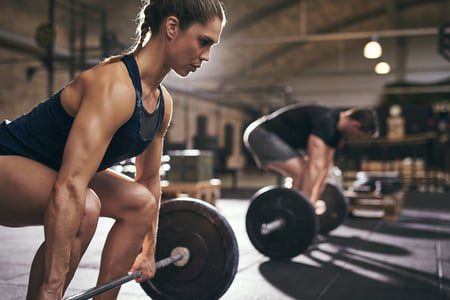
A great exercise to build overall body strength!
However, for muscle building purposes, you can simply modify the traditional deadlift by using a somewhat lighter load. Then when executing the exercise you would lower the weight to only a few inches off the floor without it touching, and immediately raise back up again and repeat.
In this way, you are keeping constant tension on the muscles and thus have turned what is normally a strength-building exercise into a very effective muscle building exercise to build bigger quads, hamstrings, and glutes.
Performing this nonstop for 6-10 reps with constant tension on your muscles creates what is known as hypertrophy. Thus, resulting in muscle growth.
So now what if I told you that using dumbbells could be even more beneficial and could provide you with more advantages and flexibility and exercise variations than using just a barbell. Would you be interested in learning more?
Before we examine dumbbell deadlifts any further, let’s first take a look into what muscles are targeted with various dumbbell deadlift exercises.
Also see my Top 10 Sandbag Lunges for Bigger Glutes & Smaller Waist
What Muscles do Deadlifts Work?
We have already learned that when performing deadlifts to grow muscles, it is better to perform exercises that leave your muscles under constant tension. This pushes the most blood to your targeted muscles and results in better hypertrophy.
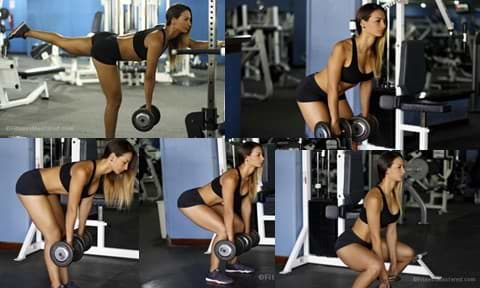
Here are a few deadlift variations that target different muscle groups. Each exercise varies only slightly in execution, but all work the muscles they target very effectively.
Here Are My Top 5 Deadlift Exercises and the Muscles Worked
#1 Romanian Deadlift
The Romanian deadlift is basically a traditional deadlift but without letting the weight ever touch the floor between reps. Furthermore, when performing the Romanian deadlift you do not squat as you do with the traditional deadlift, and you hinge at the waist while simultaneously bending at the knees.
The Romanian deadlift keeps constant tension on the targeted muscles as opposed to the traditional style deadlift.
Nonetheless, contrary to popular belief, a study from PubMed Central through NBCI on “An electromyographic and kinetic comparison of traditional and Romanian deadlifts” shows that the traditional deadlift actually activates more glute fibers than does the Romanian deadlift.
However, remember that the traditional deadlift also activates your quads more than the Romanian. So if you are looking to build bigger glutes while keeping your legs slender, then you may want to choose the Romanian over the traditional deadlift.
To simplify, you would hinge and semi-squat until the weight is only a few inches from the floor and immediately return to the upright position and repeat.
- Romanian Deadlift muscles worked:
- Primary muscles worked: glutes, quads, and hamstrings
- Secondary: lower back, core, adductors
#2 Stiff Leg Deadlift
The stiff leg deadlift is by far the most popular deadlift, especially among females when it comes to building bigger glutes. However, these are also ideal for building very strong hamstrings and glutes. This deadlift is also performed without dropping the weight to the ground and without pausing.
- Stiff Leg Deadlift muscles worked:
- Primary muscles worked: hamstrings, glutes, and lower back
- Secondary: quads, core, adductors
#3 Single Legged Dumbbell Deadlift
The single leg dumbbell deadlift can be performed using one or two dumbbells. I would suggest using one dumbbell for this exercise so you can use the other hand to support yourself. In this way, you can concentrate more on the exercise and muscles being worked with this deadlift without being distracted by keeping your balance.
This exercise is very similar to the Romanian deadlift. Except for the simple fact that you are only using a single leg. The muscles worked for this deadlift are primarily the glutes and the hamstrings.
- Single Leg Deadlift muscles worked:
- Primary muscles worked: hamstrings and glutes
- Secondary: lower back and quads, core, adductors
#4 Sumo Dumbbell Deadlift
The Sumo dumbbell deadlift is another great way to target your glute muscles. This exercise is very similar to the Romanian deadlift except that you position your feet wider than shoulder-width apart. You can also either use one or two dumbbells for this DB deadlift.
- Sumo Deadlift muscles worked:
- Primary muscles worked: glutes and quads
- Secondary: hamstrings, core, adductors
#5 Traditional Dumbbell Deadlift
The traditional dumbbell deadlift is very effective at activating the glutes and quad muscles. Lowering the dumbbells all the way to the ground, with or without a pause, forces you to bend your knees more and creates a deeper squat position than any of the other deadlift variations.
This motion puts more stress on the glutes and quads. And since traditionally more weight is used for this exercise, the additional load also makes your glutes and quads work harder than the other deadlifts.
The benefit of using dumbbells, even if you cannot go as heavy as with barbells, is the added mobility and range of motion. You can squat much lower with the dumbbells than you can with a barbell.
- Traditional Deadlift muscles worked:
- Primary muscles worked: glutes and quads
- Secondary: hamstrings, core and lower back, adductors
Top 5 Dumbbell Deadlift Workouts with Illustration – Form and Execution
Many of you may already be familiar with the proper execution of each dumbbell deadlift workout shown below. However, if not, or you just need a refresher, the following will give you a quick step-by-step on how to perform each exercise correctly to achieve the best results while also keeping it safe.
#1 Romanian Dumbbell Deadlift Form & Execution
The muscles worked for the Romanian dumbbell deadlift are the quads as the primary with marginal lower back and glute muscle activation.
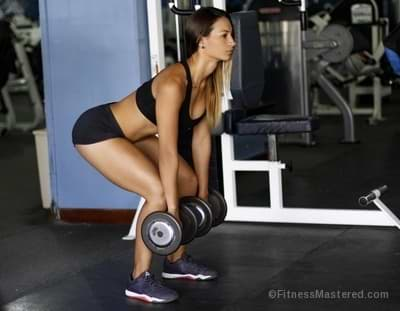
- Foot placement should be approximately shoulder-width apart.
- Position dumbbells directly beside each leg and bar being parallel to the leg.
- While keeping your back and head in a neutral position at all times and your shoulders pulled back and chest out, while actively bending your knees, lower the weights in front of you until they are only a few inches from the floor.
- Before touching the floor, drive straight back up using your quads while keeping your back and neck neutral, and squeeze your glutes in the top position.
- Repeat for 6 to 12 reps and 3 to 4 sets, or whatever workout routine you may be following.
#2 Stiff Leg Dumbbell Deadlift Form & Execution
The muscles worked for the stiff leg dumbbell deadlift are the glutes and hamstrings as the primary with marginal lower back and quad muscle activation.
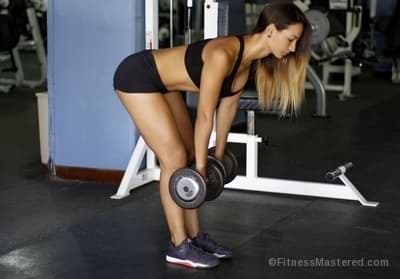
- Place your feet anywhere between hip-width and shoulder-width apart.
- While standing straight and knees slightly bent, position the dumbbells firmly in each hand with palms facing you or at a slight angle; whichever is more comfortable.
- Keeping your head and back neutral and shoulders pulled back, with a slight bend in the knees slowly hinge at the hips and bend over lowering the weights just short of touching the floor.
- Note that this is not a squatting exercise. You must keep your knees locked in a slightly bent position.
- It is important to feel the stretch in your glutes and hamstrings and get those muscle fibers fired up.
- Concentrate on hinging as you lower the weights. This puts more emphasis on your glutes and hamstrings and less on your lower back.
- Raise back up to the starting position and repeat.
Unlike the Romanian dumbbell deadlift, be aware that you will be concentrating more on the negative execution for the stiff leg deadlift.
#3 Single Leg Dumbbell Deadlift Form & Execution
The muscles worked for the single leg dumbbell deadlift are also the glutes and hamstrings as the primary with marginal lower back and quad muscle activation.
The single leg dumbbell deadlift is very similar to the stiff leg deadlift.

- Again, always keep your back and head neutral with shoulders pulled back. And never arch or round your back during any of these exercises.
- Standing straight and holding one dumbbell in front of the leg you will be working out, hold on to something with the other hand for support. I strongly believe in using one dumbbell over two since it is safer and adds more stability to the exercise.
- While hinging at the waist, keep your knees slightly bent, and lower the weight to within a few inches off the floor.
- You will raise your non-active leg off the floor when lowering the weight and drop it back down again when you raise back up.
- Drop slowly and feel the stretch in your glutes and hamstrings on the negative, and slowly return to an almost upright position and repeat.
Here is a great demo by Nikkiey Stott showing how to perform the single leg dumbbell deadlift while using one arm as support.
#4 Sumo Dumbbell Deadlift Form & Execution
The muscles worked for the Sumo dumbbell deadlift are also the glutes and hamstrings as the primary with marginal lower back and quad muscle activation.
The Sumo Dumbbell deadlift will target your glutes differently and in most cases help you feel the stretch more easily since your feet are positioned much wider apart than any of the other deadlifts.
Additionally, you also have the option of using 1 or 2 dumbbells for this exercise.
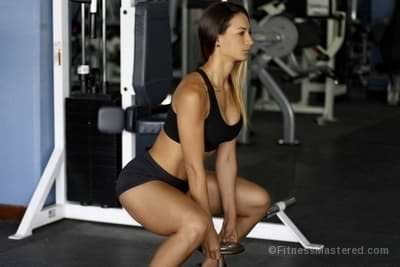
- As with all deadlifts maintain proper posture and strict form.
- Position your feet wider than shoulder-width apart with toes pointing slightly outward.
- Hold either one or two dumbbells straight down in front of you and then lower and raise the weight the same as you would when performing the Romanian Dumbbell Deadlift – actively bending at the knees.
- And repeat.
#5 Traditional Dumbbell Deadlift Form & Execution
The traditional dumbbell deadlift primarily focuses on the quads but also generates a good amount of glute muscle activation due to the deeper squat motion.
So if you looking to pack on some size to your glutes, this would be a good deadlift variation to add to your workout routine.
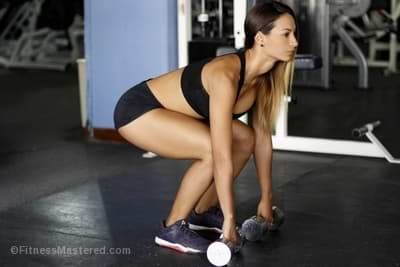
- Again, it is best to position your feet hip or shoulder-width apart.
- While standing upright and holding one dumbbell in each hand, keep your arms straights and palms facing the front or sides of your quads.
- Slowly lower the weights, while bending at the knees and forcing your hips back to generate the additional stretch in your glutes.
- You can either bring the weights completely down to the floor and pause a second, or just shy of touching the floor raise back up to the upright position and repeat.
- Between each rep try squeezing your glutes at the upright position before lowering the weight again.
10 Helpful Tips for Proper Deadlift Form & Safety
When performing exercises involving the use of heavy weights, it is especially important that you know how to do them correctly. Proper deadlifting form and execution not only makes the exercise more effective but also helps keep you safe from injuries.
I have included a video from the team at Bowflex with a quick demonstration of how to correctly perform the dumbbell deadlift below.
#1 Keep a Neutral Back and Head Position
Always keep your back and head neutral when performing all deadlift variations. This means keeping your back straight, not arched back or curved forward. The same goes for your head position. Always keep your head aligned with your spine.
Basically, don’t bend your head back to look up when lowering your weights. And don’t tilt your head back when you pull back up. A trick is to concentrate on keeping your chin in the same position throughout the entire exercise.
#2 Shoulders Back and Chest Out
Proper form not only includes a neutral back and head position but also keeping your shoulders pulled back and your chest out. Again, this will help prevent injuries but also helps assist in keeping your spine neutral.
#3 Never Lock Out your Knees
Always keep your knees slightly bent when performing the stiff leg deadlift and the single leg dumbbell deadlift.
#4 Keep Core Muscles Tight
Always keep your core muscles tight when performing deadlifts. Tightening your core helps stabilize your body which helps assist in the exercise but also helps keeps you safe from injuries.
#5 Keep arms Straightened
Bending your arms, especially when using heavier weights, can cause additional stress and tension on the elbow joint and biceps. As a result, this could lead to unwanted injuries to the elbow or bicep tears.
#6 Hinge at the Hips
Always hinge at the hips when doing the stiff leg deadlift and the single leg deadlift. Feel your glutes push our behind you and actively concentrate on producing a good stretch in your glutes and hamstrings as you lower your weights to the floor.
You’ll know if you’re not hinging properly if you are feeling most of the tension in your lower back rather than your glutes and hamstrings.
#7 Warm-up and Stretching
Never go for the heavier weights and start exercising without warming up. If you’ve already performed other leg routines such as leg presses or squats, then you are obviously already warmed up. Otherwise, performing some stretching exercises or performing your deadlifts movements without weights or very light weights can prevent unnecessary injuries.
#8 Squeeze your Glutes
Squeezing your glutes at the top of each exercise is a great way to keep your glutes activated. Some believe that throwing your hips forward is the same thing. But this method is incorrect and can cause more strain on your lower back. A better method is to concentrate more on squeezing your glutes.
#9 Weight Position
Keep weights pulled in at the front or side of your legs and not out in front of your body. This keeps the load off your back and puts more tension on the targeted muscles such as quads, glutes, and hamstrings.
#10 Don’t Go Too Heavy
Many make the mistake of going too heavy. This can compromise your form and cause your back to round forward. Thus, resulting in lower back injuries or muscle tears. For this reason, It is always better to go lighter to maintain strict form. You may also want to check STACK for more tips on proper form and how to avoid more common deadlifting mistakes.
Top 7 Dumbbell Deadlift Benefits
The various exercises above are very effective workouts for targeting your quads, glutes, and hamstrings. However, there are many more advantages to be had using dumbbells for deadlifts. So let’s check out the many benefits dumbbell deadlifts have to offer.
#1 Exercise Variations
Using dumbbells to perform deadlifts provides you with much more flexibility, and thus more exercise variations. Take for instance the single leg deadlift. It offers you the possibility to concentrate all your energy on pumping blood into just glute and hamstring. But also gives you the opportunity to use the other free hand to support your balance.
#2 Muscle Targeting
These dumbbell exercises are ideal for targeting your quads, glutes, or hamstrings. With the constant tension you are providing, plus the added stretch and control you have by using dumbbells, you can easily generate the kind of pumps that guarantee hypertrophy.
#3 Hand Position
Unlike the barbell, you can easily adjust your hands or wrist angle to a position that is more comfortable for you. This, in turn, can put less stress on your wrists or even shoulders when performing heavier routines.
For example, when performing the traditional deadlift you would typically position your hands directly ahead of you around the barbell. However, with the DB deadlift, you can position the bars at any rotation. The best position for this movement would be to position the dumbbells to the outside of each leg and gripping the dumbbells with your palms facing your legs.
#4 More Control
Using dumbbells can give you more flexibility to control the position of the weights you would otherwise not have with a barbell. In this way, you can better control your center of gravity for proper weight distribution. For instance, moving the dumbbells close to your sides help stabilize your position, or put more tension on your quads or glutes and less on your lower back.
#5 Unilateral Training
Unilateral training gives you the option to train muscles independently. So in this case, you can work each leg separately when using dumbbells for your deadlifts. An option you do not have when using a barbell.
Unilateral training gives you the added benefit of better targeting a specific muscle. This enables you to put extra attention on a muscle that might be weaker on one side of the body. Muscle imbalances result in uneven body symmetry, and dumbbells are the perfect solution to remedy this problem.
#6 Workout from Home
Not everyone is fortunate enough to have access to a gym. So investing in some dumbbells to use at home is a feasible option. Dumbbells are much easier and convenient than a barbell and weight plates.
Dumbbells take up very little space and can easily fit into your home or apartment. Another great way to save on space is by using adjustable dumbbells.
#7 Cost
Besides using up very little space, dumbbells are also much more affordable. Buying a barbell and weight plates would put you out much more than dumbbells ever would. Plus, if you’re in a crunch, you could start with only the single leg dumbbell deadlift, and buy one dumbbell for the weights you need rather than a set of 2 for each.
Is the Dumbbell Deadlift better than the Barbell Deadlift?
I personally believe dumbbell deadlifts to be more beneficial overall than barbell deadlifts. For the greater fitness population, I would say that the dumbbells offer far more advantages.
Dumbbells by far offer more flexibility and increased motion and exercise variations than barbells. They are much less expensive, require far less space if used at home, and are less likely to cause back injury due to overloading.
Gender Might Make a Difference
More and more women are more and more into the squat and deadlift exercise craze for building bigger glutes. Deadlifts have become very popular exercises for women. It is also true that most women prefer working out at home over going to a public gym.
For this reason alone, I would say that for the vast majority of women, the dumbbell deadlift is by far the most beneficial and better choice.
Guys, on the other hand, are mostly concerned about how much weight they can lift. Thus, it’s more about building strength than building bigger glutes or hamstrings. In which case, I would recommend the barbell deadlifts.
Fitness Goals May Be a Deciding Factor
Then you have your professional bodybuilder who may be more interested in building muscle mass but also gaining strength. So for them, a combination of both dumbbell deadlifts and barbell deadlifts may be the preferred option.
And then you have athletes and powerlifters whose primary concern is strength and power. Obviously, the better choice for them would naturally be the barbell deadlifts.
So basically, to answer the question… which is the better option for you?
Simply put, the better deadlift is the one that best suits your individual needs and fitness goals.
More Suggested Reading:
Adjustable Kettlebells are also a great alternative to dumbbells – save money and space!

With over 30 years of experience in strength training and fitness, Mark LaRue is the founder of Fitness Mastered, a blog to help educate fitness enthusiasts of all fitness levels, ages, and gender. We write topics that range from weight training tips and exercise routines to home workout machine and fitness related product reviews, to name a few.

